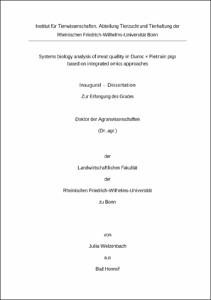Welzenbach, Julia: Systems biology analysis of meat quality in Duroc × Pietrain pigs based on integrated omics approaches. - Bonn, 2017. - Dissertation, Rheinische Friedrich-Wilhelms-Universität Bonn.
Online-Ausgabe in bonndoc: https://nbn-resolving.org/urn:nbn:de:hbz:5n-47792
Online-Ausgabe in bonndoc: https://nbn-resolving.org/urn:nbn:de:hbz:5n-47792
@phdthesis{handle:20.500.11811/7025,
urn: https://nbn-resolving.org/urn:nbn:de:hbz:5n-47792,
author = {{Julia Welzenbach}},
title = {Systems biology analysis of meat quality in Duroc × Pietrain pigs based on integrated omics approaches},
school = {Rheinische Friedrich-Wilhelms-Universität Bonn},
year = 2017,
month = jul,
note = {Water holding capacity and drip loss are important commercially interesting meat quality parameters with low heritabilities and complex genetic and metabolic background. The aim of this thesis was the application of different statistical approaches to integrate the omics levels genome, transcriptome, proteome, metabolome and phenotype in 100 Duroc × Pietrain pigs to elucidate the genetic and metabolic background of meat quality, paying special attention to drip loss. The pigs were genotyped and performance tested. The metabolome, proteome and transcriptome were profiled in muscle samples of the animals.
In the first study, metabolite profiles were analysed based on different statistical procedures to elucidate the underlying biochemical processes and to identify potential metabolite indicators for drip loss, pH1, pH24 and meat color. In case of drip loss, the procedure ‘Random forest regression’ was the most suitable method to identify reliable biomarkers. Based on a systems biological approach, in a second step different omics levels were integrated to increase the information density for the analysis of meat quality and carcass composition traits. The omics analyses were applied as promising alternatives to standard genetic association studies and the metabolic phenotypes were used as more accurate traits to characterize underlying functional pathways and candidate genes. Therefore, metabolite and protein profiles were used to perform an enrichment analysis that revealed the sphingolipid metabolism with significant influences on drip loss. Based on the identified pathways, metabolites and proteins were selected as ‘intermediate phenotypes’ for drip loss.
In the third study, the most promising metabolic traits for drip loss and other meat quality and carcass composition traits were picked using a network analysis that integrated all quantified transcripts, metabolites and proteins. In the following, besides the conventional production traits, the selected ‘intermediate phenotypes’ (single metabolites/proteins or combined metabolic traits) were analyzed in genome-wide association studies (GWAS). As a result, several highly interesting candidate genes for drip loss and carcass composition on Sus scrofa chromosomes 5 and 18 were identified.
Due to the higher information density between genotype and phenotype, we hypothesize that GWAS based on intermediate phenotypes are able to improve the statistical power in the identification of reliable candidate genes and to avoid false positive, redundant results. In conclusion, our omics approaches provide comprehensive insights in the genetic variation of genes directly involved in the metabolism of production traits.},
url = {https://hdl.handle.net/20.500.11811/7025}
}
urn: https://nbn-resolving.org/urn:nbn:de:hbz:5n-47792,
author = {{Julia Welzenbach}},
title = {Systems biology analysis of meat quality in Duroc × Pietrain pigs based on integrated omics approaches},
school = {Rheinische Friedrich-Wilhelms-Universität Bonn},
year = 2017,
month = jul,
note = {Water holding capacity and drip loss are important commercially interesting meat quality parameters with low heritabilities and complex genetic and metabolic background. The aim of this thesis was the application of different statistical approaches to integrate the omics levels genome, transcriptome, proteome, metabolome and phenotype in 100 Duroc × Pietrain pigs to elucidate the genetic and metabolic background of meat quality, paying special attention to drip loss. The pigs were genotyped and performance tested. The metabolome, proteome and transcriptome were profiled in muscle samples of the animals.
In the first study, metabolite profiles were analysed based on different statistical procedures to elucidate the underlying biochemical processes and to identify potential metabolite indicators for drip loss, pH1, pH24 and meat color. In case of drip loss, the procedure ‘Random forest regression’ was the most suitable method to identify reliable biomarkers. Based on a systems biological approach, in a second step different omics levels were integrated to increase the information density for the analysis of meat quality and carcass composition traits. The omics analyses were applied as promising alternatives to standard genetic association studies and the metabolic phenotypes were used as more accurate traits to characterize underlying functional pathways and candidate genes. Therefore, metabolite and protein profiles were used to perform an enrichment analysis that revealed the sphingolipid metabolism with significant influences on drip loss. Based on the identified pathways, metabolites and proteins were selected as ‘intermediate phenotypes’ for drip loss.
In the third study, the most promising metabolic traits for drip loss and other meat quality and carcass composition traits were picked using a network analysis that integrated all quantified transcripts, metabolites and proteins. In the following, besides the conventional production traits, the selected ‘intermediate phenotypes’ (single metabolites/proteins or combined metabolic traits) were analyzed in genome-wide association studies (GWAS). As a result, several highly interesting candidate genes for drip loss and carcass composition on Sus scrofa chromosomes 5 and 18 were identified.
Due to the higher information density between genotype and phenotype, we hypothesize that GWAS based on intermediate phenotypes are able to improve the statistical power in the identification of reliable candidate genes and to avoid false positive, redundant results. In conclusion, our omics approaches provide comprehensive insights in the genetic variation of genes directly involved in the metabolism of production traits.},
url = {https://hdl.handle.net/20.500.11811/7025}
}






